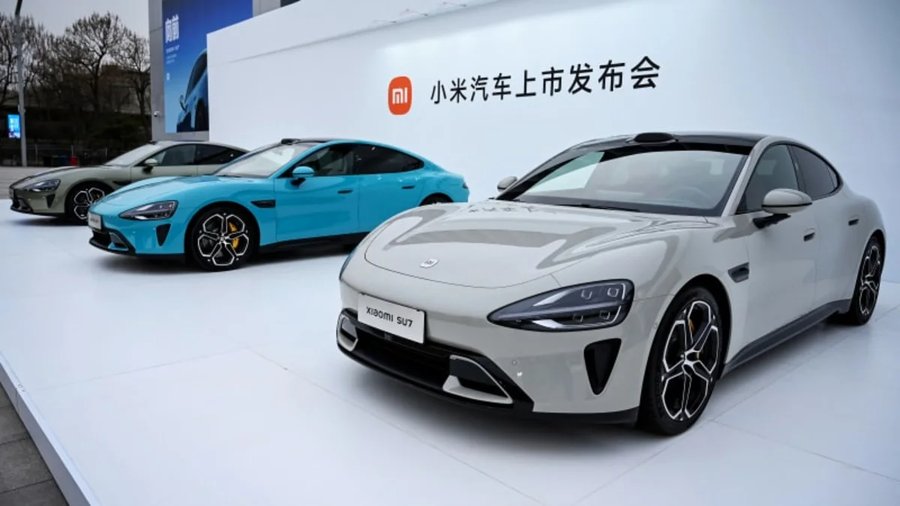Xiaomi SU7 Comparable To Audis, Makes No Rookie Mistakes: YouTuber

In China's brutally competitive electric vehicle market where about 100 rivals are jostling for a share of the EV pie, a smartphone manufacturer's entry into the space is nothing short of bold.
Consumer electronics giant Xiaomi released its first electric car in China recently, and it has taken the market by storm. It's already sold out for 2024, garnering nearly 90,000 reservations in just 24 hours. Waiting times have reached seven months and the company added $4 billion to its market value overnight, surpassing Ford and General Motors.
Before diving deep, here are some numbers. The SU7 starts at 215,900 yuan ($29,900). The SU7 Pro goes for 245,000 yuan ($33,990), whereas the SU7 Max costs 299,900 yuan ($41,500). A 101-kilowatt-hour, 800-volt battery powers the top Max variant. It churns 672 horsepower and delivers about 800 kilometers of CLTC range (about 370 miles EPA).
Unlike upstarts and legacy carmakers struggling with EVs on their first attempt, Xiaomi has knocked it out of the park, according to Telescope. The headlamps are reminiscent of the Mclaren 720S, but the overall proportions are traditional sedan-like. That's not a bad thing because low-slung, aerodynamic sedans typically excel in efficiency. The Tesla Model 3 and Hyundai Ioniq 6 are great examples.
Inside, things get sporty. The driving position and visibility have a mid-engined sports car feel, according to Telescope. The dashboard reveals itself with a rotation to greet the driver. Customizability is also impressive—the physical buttons under the infotainment are magnetic add-ons and there are factory-fitted mounts on the driver- and passenger-side dashboard and the center of the rearview mirror for Go Pros.
One of the highlights is the seamless integration with Xiaomi’s exhaustive range of smartphones, tablets and connected devices. This is part of the brand’s “Human x Car x Home” ecosystem, all connected via the new HyperOS platform.
The horizontal infotainment system allows owners to mirror their smartphones and they can also pin a particular app on the screen. Even though users can configure Xiaomi tablets for the rear passenger screens, the press cars seemed to use Apple iPads.
Xiaomi, like several other Chinese automakers including Li Auto, Great Wall Motors, and Zeekr, also uses Nvidia’s Orin Drive platform for computing power and ADAS functions.
That said, the reviewer mentions the highway cruise control wasn’t fine-tuned. Different drive modes also didn’t change the steering feel all that much. But overall, it’s hard to find faults in the SU7. The driveability is comparable to top automakers like Audi and there are no rookie mistakes in that department.
Much of the SU7’s design finesse can be attributed to the brand hiring BMW AG designer Tianyuan Li and getting consulting help from industry veteran Chris Bangle, as Bloomberg reported today.
And unlike Apple, Xiaomi never planned to go solo on the engineering front, where it partnered with established carmaker Beijing Automotive Group Co (BAIC), a Chinese-state-owned company.
Even though the SU7 seems to have won people over with its Tesla-rivalling specs, it remains an unproven car. The coming weeks and months will reveal if buyers are willing to wait seven months for their EVs. They can simply pick the refreshed Model 3 or several other options in what is the most competitive EV market in the world.
Xiaomi SU7, The Smartphone Maker’s First EV, Sold Out For 2024 In 24 Hours
Customers in China are facing wait times as long as seven months to get their cars delivered.
The Xiaomi SU7 made a big splash in China late last week. It’s the first-ever car made by a company known worldwide for its consumer electronics. Still, people flocked to the firm’s website to place orders for the battery-powered sedan that competes directly with the Tesla Model 3, although the Chinese EV is slightly larger and also cheaper.
Ten thousand people in China preordered the SU7 within the first four minutes of the order form opening last Thursday. After just 27 minutes, 50,000 orders piled up, and by the end of the day, Xiaomi had received nearly 90,000 preorders for its inaugural car.
That’s a lot of interest for a brand-new car from a company that has never made a car before. As a result, people who placed a 5,000-yuan ($850) deposit for the Xiaomi SU7 will have to wait up to seven months to get their hands on the car, according to a report from Reuters, which checked the delivery timelines on the company’s car app.
Deliveries are set to begin by the end of this month, but the most expensive model known as the Max, which costs 299,900 yuan ($41,500), has a delivery window between 27 and 30 weeks, meaning it will likely arrive at customers next year.
The entry-level Standard version of the SU7, which starts at 215,900 yuan ($29,900), as well as the SU7 Pro, which goes for 245,000 yuan ($33,990), may take between 18 and 21 weeks to be delivered.
Powered by electric motors that were developed in-house by Xiaomi, the SU7 is either rear-wheel drive or all-wheel drive, depending on the trim. The car is based on an 800-volt architecture and the high-voltage batteries that offer up to 515 miles (830 kilometers) of range on the CLTC procedure are sourced from either CATL or BYD.
The car itself will be built under contract by China’s BAIC at a new factory in Beijing which has an initial production capacity of 150,000 vehicles per year and 300,000 vehicles per year in the second phase.
The Xiaomi SU7 is around $4,000 cheaper than the Tesla Model 3 in China but boasts a higher driving range, more screens inside, a head-up display, and a somewhat more upmarket interior with tech that integrates with Xiaomi's consumer products. Although there are cheaper variants out there, like the Zeekr 007, it looks like Xiaomi’s marketing efforts have paid off in what is arguably the most competitive EV market in the world.
Nouvelles connexes


